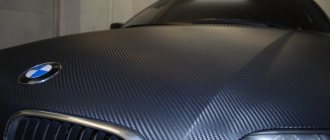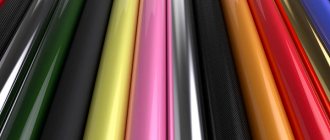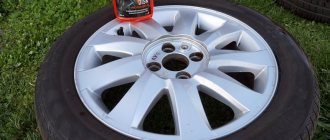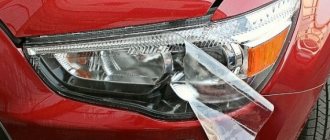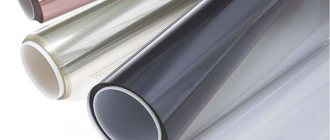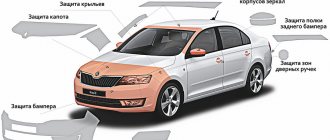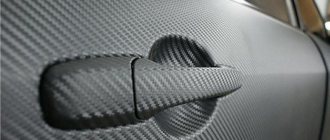At least half of car owners think about changing the appearance of their vehicle after 3 years of ownership. But a radical change in the exterior or interior is considered an expensive pleasure. The output is carbon film. Modern material makes it possible to quickly and inexpensively transform the appearance of a car without resorting to major work on the body.
What is carbon film
The material has become widespread not only in the domestic market. It is used quite often in America, Europe and Asia. And the reason is simple. The film itself is represented by an adhesive base with a special carbon fiber pattern. When specialists coat vehicle parts with this material, it appears as if they are made of pure carbon fiber. The benefit is low cost.
With the help of carbon film for cars, each owner can give a unique appearance to their vehicle. A large number of companies produce inexpensive material. Despite the identity of different brands, quality can vary significantly.
Important points about DIY work
You can make stylish and original tuning yourself - you just need to order carbon film and go through the preparatory stage. Difficulties may arise during your first attempts. To avoid trouble, you should follow several rules:
- After gluing, large parts should be left for several hours in a warm room;
- for a month after such tuning, you should not wash the car at car washes;
- when cutting out a stencil, leave a large margin - it will be easier to secure;
- Bubbles and folds remain on the bends. In such places, the squeegee can damage the film, so it is recommended to smooth them with your finger;
- In order for the film to remain beautiful and flawless for a long time, it is necessary to wipe it with a napkin every day. Don't use a lot of detergents. Dirt also negatively affects the appearance of the carbon film.
The complete pasting process lasts about an hour; if this is your first experience, it takes a little longer. The result is a new, stylish and status car at an affordable price.
Advantages and disadvantages of carbon
The first characteristic can be considered a non-standard appearance. Moreover, this trait is both positive and negative. Why? The answer is that some motorists like the material, and some consider such tuning “collective farm”.
First of all, you should take into account the undeniable advantages of carbon fiber film:
- The ability of the composition to protect paintwork from direct rays of the sun;
- Protection of the body from mechanical impact. This is the most common cause of all kinds of damage to the paint layer;
- Masking obvious defects of certain parts;
- The film (in particular glossy film) is resistant to both sudden temperature changes and prolonged exposure to high and low temperatures;
- Chemical protection. No reagents used to treat the road surface will damage the body elements;
- Comparative durability of the layer. If the owner of the vehicle has covered his car with high-quality material, then you can forget about plywood for 5-7 years;
- Easy to clean. Carbon film can be washed on a car using the most common cleaning products;
- Easy to apply and remove.
The disadvantages largely relate not so much to operational characteristics as to production quality. In any case, you can find ultra-low prices on the market for a product that will lose all its positive characteristics in just a couple of months. Therefore, it is better to give preference to popular brands of carbon fiber film in the middle price segment.
What is carbon?
Before moving directly to the film material, which is mostly used in car tuning, you need to consider the original - real carbon fiber plastic, or carbon plastic. This is a composite - a material made from several types of raw materials.
Carbon is an innovative material: it is a fabric made of carbon threads with the addition of epoxy resins and rubber fibers. The peculiarity of the material is its original, recognizable texture, the reason is the unique interweaving of threads. The most popular option is still the “herringbone”.
Areas of application of carbon fiber reinforced plastic
Nowadays carbon is used in those industries that require materials that are elastic, super strong, but as light as possible. For example, carbon fiber has become indispensable in the aviation and space industries and in the production of prosthetics. The automotive industry is another “field of activity” for carbon fiber. Since this material is expensive, it is used only for premium models: automatic transmission handles, inserts for the steering wheel, panels and other decorative elements are made from carbon fiber.
Sports is another area of application for carbon fiber. Carbon is actively used for finishing the interiors and bodies of racing cars; the main parts of motorcycles, boats, snowmobiles, etc. are made from it. In this case, the main advantage of the material is the combination of “minimum weight and lightness.” Carbon is lighter than aluminum and steel: 20% and 40%, respectively. However, in strength it is not inferior to any alloy.
Disadvantages of carbon
Its high price is the most significant disadvantage of an almost flawless material, if we talk about car owners who passionately want to change the appearance of their “horse”. For this reason, not everyone can afford to tune a car with expensive carbon fiber, and many owners in Russia simply do not see the point in such expenses. There is one reason for these doubts: this is another drawback of natural material.
The original carbon has an “Achilles heel”: it is inability to withstand strong point impacts. Even a small stone thrown from under the wheel of a moving car can cause the replacement of a carbon-plastic element, which, given our “wonderful” (in most regions) roads, will turn into a very expensive pleasure. Damaged parts cannot be restored.
Types of carbon film
With the increase in demand for this type of automotive products, the number of manufacturers has increased. New colors are released every month, but there are only a few standard types.
Types of carbon films
The most common type is 2D film . It is easy to produce and inexpensive. The image is printed on the material and visually imitates a carbon surface. To protect the composition from rapid wear and all kinds of damage, an additional laminated layer is applied to it. That is, the whole technology consists of 2D printing a carbon coating pattern and applying a special protective layer.
The next film option is 3D carbon . As a rule, this material is used exclusively on individual elements of the vehicle body. It has a relief surface. Visually, this type of product exactly copies the texture of carbon fiber thanks to the three-dimensional image.
In addition, the quality of the workpiece can be assessed by touch. By touching the surface you can feel individual microscopic stripes. The result is a high-quality surface that can change shade when viewed from different angles.
4D images have a higher price This material is practically not found in ordinary stores. To purchase 4D carbon film for a car, you need to contact a specialized service. As a rule, such points of sale of high-quality elements for repairs and tuning operate in large cities. They always have a large assortment.
There are also improved varieties of carbon film - 5D and 6D . Visually, this layer looks a little richer on the surface of the vehicle than previous options. Although, it consists of the same components:
- Substrate;
- High quality film;
- Durable layer of protection.
Modern material is quite expensive. Therefore, the majority of owners use carbon-look film for car interiors.
How do 2D, 3D, 4 D, 5D and 6D carbon films differ visually and by touch in the video:
Gluing carbon film to a car using dry and wet methods
There are two ways to stick the film on the surface. If you are a beginner, it is better to consult with professionals; they will tell you the right way to use the selected material. There are two methods: dry and wet. To determine the benefits, it is necessary to characterize each:
- Dry method. The carbon film is applied to a clean, completely dry and grease-free surface and secured with magnets. Cut the blanks with sharp scissors, leaving about 3 cm at the edges, make an incision and remove the protective layer. The procedure must be done slowly, moving from the center to the edges. Use a special squeegee to smooth the surface without leaving bubbles. If they still exist, you can get rid of them with a hairdryer. Repeat the manipulation with each part, secure the remaining pieces on the inside, use only high-quality glue.
- Wet method. First, you should clean and degrease the surface in the same way as with the dry method. Then a spray bottle is additionally used. With its help, the soap solution must be sprayed evenly over all parts. You need to stick it carefully, stretch the film slightly, you can use a hairdryer to increase elasticity. This method is used for uneven parts. Tuning is ready after the solution under the film has dried.
Gluing carbon film to a car using dry and wet methods
Main manufacturers and prices
Since the popularity of decorative materials is growing rapidly, many companies have begun to produce and sell them. A large selection offers different quality to suit any budget.
Three brands have gained the best foothold in the domestic market and are considered among drivers the most reputable manufacturers of carbon films for cars:
- Graphjet;
- 3M;
- Eclat.
Each of the options contains microchannels in its structure. Graphjet brand materials have a high initial adhesion rate. This means that the carbon layer will be firmly fixed in hard-to-reach places, but it will be more difficult to work with.
In turn, vinyl of the Eclat and 3M brands is characterized by a low degree of adhesion, as well as the presence of a special system for easy air removal.
3D carbon films from 3M and Graphjet are produced with identical texture and grain size, in contrast to the fine structure of Eclat.
An indisputable advantage of all three options is the increased percentage of stretching. This allows you to conveniently paste over any part of the body, stretching the material to the required state.
The standard width of 3M brand rolls is 1.22 m. As practice shows, this value is sometimes not enough for high-quality pasting at home. But Graphjet and Eclat produce carbon fiber with a width of 1.52 m.
To choose the most reasonable price, you need to decide on the desired quality. Reliable samples of the carbon layer will not be cheap. Basically, the above brands offer products at prices ranging from 200 to 850 rubles per linear meter. This can be called the average price category. If the price in the store is higher, it means we are talking about higher quality material.
Advantages of carbon film
Carbon film imitates the properties of real carbon - a material that, due to its lightness and strength, has long been established in the automotive industry market. Covering a car with carbon fiber provides a number of advantages, including:
- The film protects the body from exposure to sunlight, which can negatively affect regular paint over time.
- The carbon fiber coating withstands shocks and other mechanical impacts without leaving scratches.
- This type of coating can last more than 5 years without losing its protective properties.
- Covering a car with carbon film allows you to change its appearance without resorting to expensive painting.
- From the outside it is often very difficult to distinguish whether a particular part of the car is made of natural carbon fiber or covered with film.
- Covering with carbon fiber is much cheaper in cost compared to using real carbon plastic.
- Car wrapping with carbon fiber is much faster in time than replacing a body element or repainting it.
Initially, this type of coating was developed specifically to protect the paintwork of cars from external influences. But the expansion of the range of films has led to the emergence of a huge number of colors to satisfy the aesthetic preferences of any car enthusiast. There are also films that have a 3D and even 4D effect!
3D Vinyl
Carbon 3d is an imitation of the presence of carbon parts, which is achieved by applying a special polyvinyl chloride coating to them. This material was positively assessed by many car enthusiasts, trying to give an individual look to their car.
Carbon 3d has a number of advantages compared to “true” carbon. The main advantage is strength. Carbon is a material that does not like temperature changes and bad roads. 3D carbon is just a film glued to a part of your car, and this part can be made of any material that is resistant to shaking and temperature changes.
In addition, the film serves as an additional protective material against “third-party influence” on car parts, allowing you to maintain an impeccable appearance for a long time. An important advantage of tuning with 3D carbon fiber is its inexpensive price. Carbon-effect film is a budget alternative to true carbon, not inferior in quality and available to a wide range of car enthusiasts.
Carbon film for cars is applied to absolutely any element of the car body. Our specialists offer high-quality carbon film wrapping at an affordable price.
The extensive experience of our center’s craftsmen, the comparative cheapness of car wrapping with carbon film, and its excellent characteristics allow us to claim that it is a high-quality element of modern auto tuning.
Help your car look stylish and delight the eye with an individual design!
Cost of covering with carbon vinyl
The price of carbon fiber wrapping of a car body varies depending on the type of film chosen and the class of the car. In addition, when a car is covered with carbon fiber, the price is based on the total area of the wrap.
| Small class: Renault Logan, Chevrolet Lanos, Citroen C3, Toyota Auris…. | From 35000 |
| Middle class: Volkswagen Golf, Mazda 3, Ford Focus, Mitsubishi Lancer, Audi A4, BMW 3….. | From 40000 |
| Business Class: Toyota Camry, Nissan Teana, Audi A6, BMW 5, Ford Mondeo, Honda Accord, Lexus IS, Lexus GS, Volvo S60….. | From 50000 |
| Premium class: MB S-class, Audi A8, Lexus LS, BMW 7…. | From 55000 |
| Crossovers and SUVs: Toyota RAV4, Mitsubishi Outlander, BMW X3, Audi Q5, Volkswagen Tiguan…. | From 55000 |
| Large SUVs: BMW X6, BMW X5, Audi Q7, Volvo XC 90, Volkswagen Touareg, Toyota Prado, MB GL, MB ML….. | From 65000 |
| Minibuses: Volkswagen Multivan…. | 0t 70000 |
Painting a car is expensive, so car owners are increasingly choosing to cover their cars with film material. By covering your car with film, you can easily change the color of the vehicle. By purchasing material with inscriptions and stickers, you will create an unusual car design. Car owners do the wrapping on their own, or entrust the work to specialists at a service station.
How realistic is it to cover a car with film yourself?
Yes, it is not necessary to contact a service station if you have the skills to work with the material or want to save money. Keep in mind that the work is painstaking; it is better to start with inconspicuous parts of the machine. Once you gain experience, start applying film to the hood and other parts of the body.
Making the right choice
Carbon films for a car are selected according to the following criteria:
- Pattern and color palette;
- Number and reliability of layers. The more layers, the longer the material will last;
- Country of manufacture. The most trusted samples are from German and French brands.
You should also pay attention to the options considered. For example, 3M brand products are manufactured in the USA and Japan. Advantages: good quality and low prices. Eclat and Graphjet brands are Chinese carbon films. They are not inferior in reliability to the American equivalent.
Vinyl thickness
This criterion is also a powerful argument when choosing products. Since manufacturers focus on quality, a thin layer of carbon cannot be called unreliable.
The thickness of the carbon film varies from 0.17 to 0.22 mm. This is the default value.
Chinese companies most often produce materials with a thickness of 0.18 mm. But you shouldn’t be afraid of thinner samples either. The main thing is to know how to use carbon-look film correctly and choose a sample with a good stretchy base.
Carbon fiber vinyl film – what is worth knowing?
Now it’s worth talking about wrapping your car yourself with carbon fiber vinyl film. Is it worth doing this at all, what will you have to deal with when gluing and how expensive does it cost? Having analyzed the reviews of craftsmen and people who tried to cover their own cars with vinyl film, we came to a certain conclusion. We also emphasized several nuances, which we will now talk about.
Problem of choice
First of all, it is worth saying that carbon-look vinyl film is a rather controversial material. The thing is that choosing such a film is not as simple as it seems at first glance. First of all, the choice is between buying a cheap Chinese film and buying a more expensive and high-quality canvas. Some car enthusiasts make the mistake already at this stage, purchasing really bad material.
It is worth understanding that the Chinese film has the appropriate quality, which means that if you do not glue this film, it will begin to deteriorate very quickly. But the main property of Chinese film is that it does not transmit ultraviolet rays. Simply put, the sun's rays do not pass through Chinese vinyl film, which means that a part covered with such material will not fade in the sun. Drive with this film for a year or two, and after removing the film you will have to send the car to be repainted.
Why shouldn't you buy Chinese film?
In addition to the fact that when you remove Chinese “carbon” from a car body part, you run the risk of seeing a part there that stands out strongly from other body parts, there are other disadvantages of Chinese film. As the experience of car enthusiasts shows, when removing the film, it may happen that the varnish, paint, and in rare cases even the primer come off along with the film. Brad, do you think? Not so!
The thing is that Chinese vinyl film has a very strong adhesive base, for the quality of which, of course, no one is responsible. The most important principle that guides the production of this glue is durability. That is, it is important that the film sticks well and does not peel off. And everything seems to be fine, but only until it’s time to peel off the film. However, it is worth noting that this situation rarely happens, and only if the car was repainted, and repainted poorly.
Which brand to choose
Before purchasing a roll, you should carefully study the offers on the market and customer reviews. These two criteria will tell you which brand to choose. The best solution would be to purchase the so-called “best-selling product.” It is reliable and profitable. Otherwise, drivers would not cover their cars with such carbon film.
Among the options described, experts recommend buying the 3M brand. It can be found in any specialized store. In addition, the range of Japanese-made films is always larger than any other brands.
If the budget is not large, then you can cover the body elements with 3D Graphjet material.
How to glue carbon film
Any motorist can change the appearance of a vehicle, but not everyone knows how to properly apply carbon film. In order not to spoil the body and the purchased material, you should study in detail the principle of pasting.
Experienced specialists use two main methods of pasting:
- Wet;
- Dry.
Both methods are very practical and help to apply high-quality coating quickly. In this case, the level of adhesion is almost identical.
How to glue any carbon film using the wet method?
The principle of gluing is to use soapy water.
The first thing to do is clean the surface and then thoroughly degrease it. Then you need to measure out the required amount of vinyl and cut a piece sufficient for gluing one body part.
The next step is to apply water to the material and separate the vinyl from the paper. You will also need to wet the adhesive side.
It will be possible to cover the entire car with carbon film only if the inside of the product is thoroughly and constantly wetted. Do not allow any area of the vinyl to remain dry. But too much soap solution will not do any good.
After the wetting process, you need to carefully apply the product to the surface of the body. How to properly glue with your own hands at this stage? With a spatula! It helps squeeze water and air out of the carbon fiber smoothly and evenly. The most important thing is to start moving from the center of the part to be glued to the edges.
The result should be a perfectly smooth surface without blisters. You can use a household hair dryer to dry it. Afterwards, work with a spatula again.
If curves have formed in a certain area, you cannot do without a primer for carbon film.
Finally, all excess pieces of vinyl are removed.
Dry method
This approach cannot be called simple. Often they do not do it at home, but turn to special services for help. The employees of such centers have all the necessary equipment for wrapping the body in the shortest possible time.
How to glue carbon film dry? The main condition is a dry room in which the temperature is constantly kept above +20°.
The second condition is that the car must be cleaned of all possible defects:
- scratch;
- Rust;
- Oils.
Interesting!
The highest level of adhesion is observed when wrapping vehicles that have recently been repainted.
How to quickly stick a carbon film on a car with your own hands? You just need to follow the same principles as with professional pasting, just get a few devices:
- Construction hair dryer. It is inexpensive and will save a lot of time. In order not to spend money on buying a new hair dryer, you can ask your friends for the tool.
- Knife. You cannot use a regular or stationery type of knife! A special sample designed to work with vinyl is required.
How to stick a carbon film on a car using the dry method? The steps are almost the same as when using a soap solution. The body is cleaned and degreased. After this, the carbon should be separated from the cardboard and applied to the body. Smooth the material with a spatula, removing air to the outside.
The main step is using a hairdryer. When a stream of hot air is directed at the carbon layer, the adhesive comes into action. It firmly and reliably fixes the product to the surface of the paintwork.
Features of Carbon films
Carbon films are a high-density vinyl sheet with a three-dimensional texture that imitates carbon fiber. This explains the low price. However, due to the characteristics of vinyl itself, these materials are indistinguishable from carbon fiber and are not subject to fading, deformation and abrasion.
For coatings that imitate carbon materials, a special vinyl sheet 150 microns thick is used with additional surface treatment. Due to this, high strength is achieved. These canvases create an additional layer on the surface of the car's paintwork. And it protects against scratches due to various mechanical influences, including contact with flying rubble, dust or branches.
Vinyl coatings with imitation carbon materials are quite diverse. They differ in size and pattern pitch, color, texture. Thus, there are not only smooth options, but also those with texture (“rough”), which even more accurately imitate the structure of carbon materials.
How to remove carbon film from a car body
The main thing is not to damage the paintwork! This is the main caveat. The sad experience of many car owners has shown that the paint can easily come off along with the vinyl.
Constant exposure to sunlight, precipitation and mechanical damage significantly increase the adhesion of the material to body parts. In order to carefully remove the layer, use either a household or construction hair dryer.
For example, the task is to remove a carbon film with a pattern. The actions are performed in the following order:
- Use a special knife to trim the vinyl;
- The edge of the material begins to be pulled towards the center of the pasted part;
- At the same time, heat the surface with a hairdryer.
Heating makes the carbon elastic, as a result of which it is simply removed from the surface.
